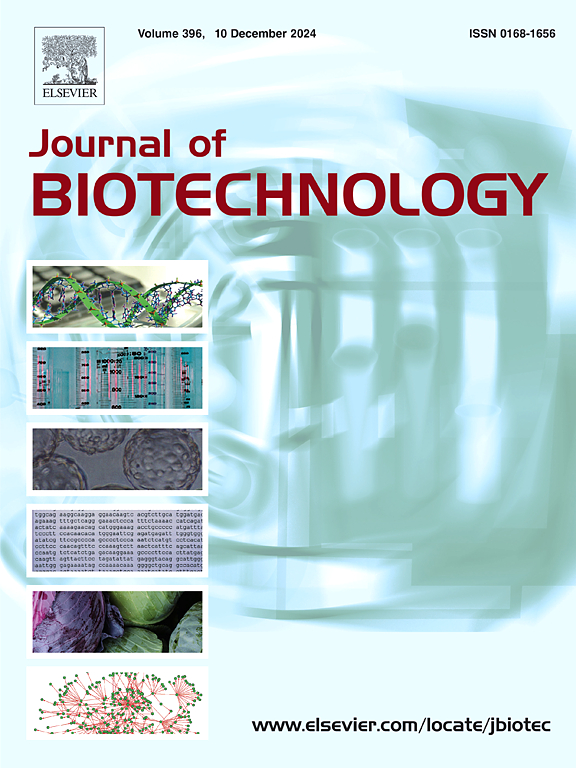利用金属-有机框架包封共表达大肠杆菌增强d -苯乳酸的级联生物合成。
IF 3.9
2区 生物学
Q2 BIOTECHNOLOGY & APPLIED MICROBIOLOGY
引用次数: 0
摘要
苯基丙酮酸作为一种多用途有机酸,其合成方法在食品、饲料、医药、化妆品等领域受到广泛关注。在本研究中,我们在大肠杆菌中共表达l -氨基酸氧化酶、d -乳酸脱氢酶和葡萄糖脱氢酶。重组的全细胞生物催化剂在l -苯丙氨酸级联酶合成d -苯乳酸方面表现出高效率。然而,它们在操作稳定性和可重用性方面的局限性阻碍了它们的广泛应用。为了解决这一问题,将共表达细菌固定在金属有机骨架(MOF) ZIF-90上。固定化大肠杆菌(E. coli@ZIF-90)的包封率和催化活性回收率分别为94.8%和92.7%。随后对E. coli@ZIF-90的物理生化特性进行了详细的研究。与游离细胞相比,E. coli@ZIF-90在酸性和碱性条件下表现出优越的稳定性,增强了热稳定性,增加了对金属离子和有机试剂的耐受性。在4℃下保存8天后,固定化细胞的残留酶活性仍在75%以上,约为游离细胞的1.7倍。经过10个循环的生物催化反应,固定细胞保持了超过80%的酶活性,而在自由细胞中观察到的残余活性为58.6%。在E. coli@ZIF-90催化的酶级联反应中,25g·l-1 L-PHE完全反应生成D-PLA 17.8g·l-1,对映体过量量(e.e)大于99.5%。本研究为获得高效、稳健的D-PLA生物合成催化剂提供了一种有前景的方法。此外,它提供了重要的见解,可扩展到更广泛的化合物的合成。本文章由计算机程序翻译,如有差异,请以英文原文为准。
Enhanced cascade biosynthesis of D-phenyllactic acid using metal-organic framework-encapsulated co-expressing E. coli
Phenylpyruvic acid, as a versatile organic acid, has attracted widespread attention in the fields of food, feed, pharmaceuticals, and cosmetics for its synthetic methods. In this study, we co-expressed L-amino acid oxidase, D-lactate dehydrogenase, and glucose dehydrogenase in Escherichia coli. The resulting recombinant whole-cell biocatalysts exhibited high efficiency in the cascade enzymatic synthesis of D-phenyllactic acid from L-phenylalanine. However, their limitations in operational stability and reusability have impeded their broader application. To address this issue, the co-expressing bacteria was immobilized on the metal-organic framework (MOF) ZIF-90. The encapsulation rate of the immobilized E. coli cells (E. coli@ZIF-90) and the recovery rate of their catalytic activity were 94.8 % and 92.7 %, respectively. The physical and biochemical properties of the E. coli@ZIF-90 were subsequently studied in detail. Compared with free cells, E. coli@ZIF-90 demonstrates superior stability under acidic and alkaline conditions, enhanced thermal stability, and increased tolerance to metal ions and organic reagents. After storage at 4°C for 8 days, the residual enzyme activity of the immobilized cells is still over 75 %, which is about 1.7 times that of free cells. Following 10 cycles of biocatalytic reactions, the immobilized cells maintained over 80 % of their enzyme activity, contrasting with the 58.6 % residual activity observed in free cells. In the enzyme cascade reaction catalyzed by E. coli@ZIF-90, 25 g·l−1 L-PHE was completely reacted to produce D-PLA 17.8 g·l−1, with an enantiomeric excess (e.e.) greater than 99.5 %. This study provides a promising method for obtaining efficient and robust biocatalysts for the biosynthesis of D-PLA. Additionally, it provides essential insights that are extendable to the synthesis of a broader range of compounds.
求助全文
通过发布文献求助,成功后即可免费获取论文全文。
去求助
来源期刊

Journal of biotechnology
工程技术-生物工程与应用微生物
CiteScore
8.90
自引率
2.40%
发文量
190
审稿时长
45 days
期刊介绍:
The Journal of Biotechnology has an open access mirror journal, the Journal of Biotechnology: X, sharing the same aims and scope, editorial team, submission system and rigorous peer review.
The Journal provides a medium for the rapid publication of both full-length articles and short communications on novel and innovative aspects of biotechnology. The Journal will accept papers ranging from genetic or molecular biological positions to those covering biochemical, chemical or bioprocess engineering aspects as well as computer application of new software concepts, provided that in each case the material is directly relevant to biotechnological systems. Papers presenting information of a multidisciplinary nature that would not be suitable for publication in a journal devoted to a single discipline, are particularly welcome.
 求助内容:
求助内容: 应助结果提醒方式:
应助结果提醒方式:


